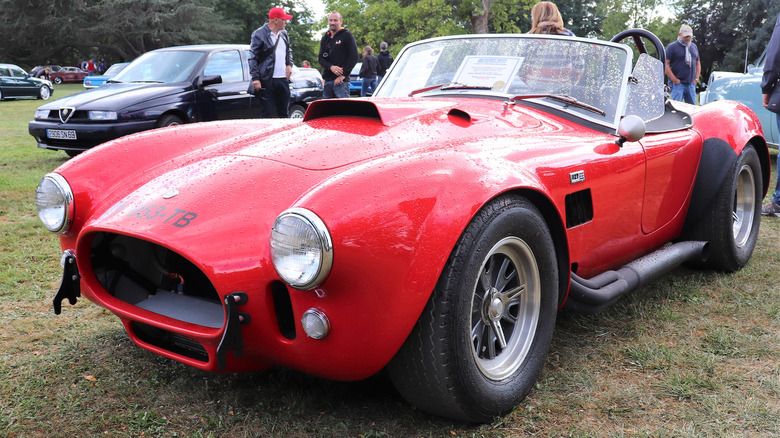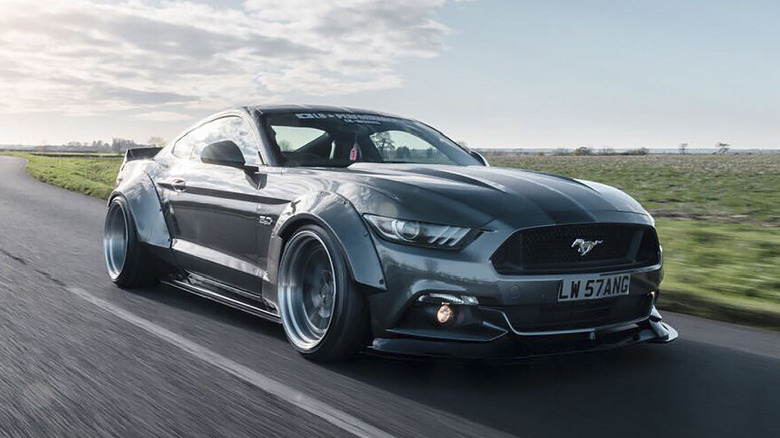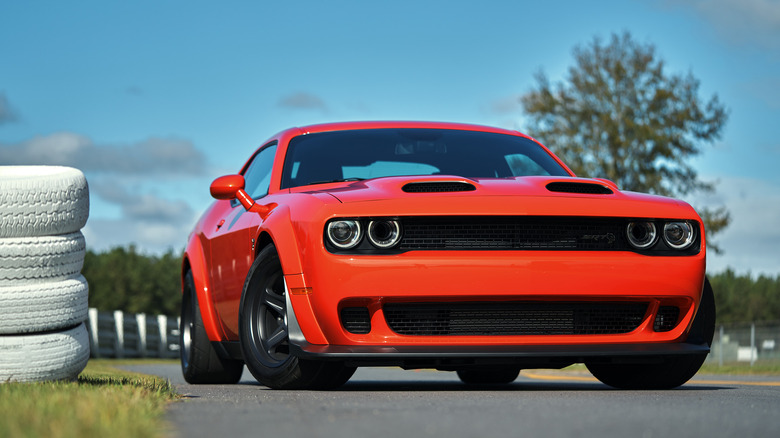5 Of The Coolest Widebody Muscle Cars And Kits
While some of the most popular widebody cars are Japanese or European vehicles, nobody is immune from the widebody treatment — not even muscle cars. And why should they be? Adding a bit of flare to your V8, straight-line machine to make it unique is precisely what muscle car owners have been doing for decades. So, it's no surprise that widebody kits have experienced a surge in popularity with the muscle car community.
What are muscle cars and what are widebody kits? Simply put, muscle cars have big, powerful engines (V8s in most cases) and are good at accelerating in a straight line. Throw some curves at 'em and they'll do okay, but a car crosses over into sports car territory if the focus shifts to handling and steering.
Whether constructed from carbon fiber, plastic, or metal, the widebody kit is a bit of bodywork that significantly widens a vehicle, typically by modifying the fenders and sometimes adding suspension mods to get the wheels/tires to match up with the new exterior. But which ones are the coolest? And are there any of the factory widebody cars that can compete with the coolest aftermarket setups?
Hoonicorn Mustang
Ken Block and the Hoonigan cars revolutionized the car world. They changed how we viewed what's possible in a car, especially if you have the budget to shut down public streets. The Hoonigan team showed us that your imagination is your only limit when you've got an ultra-talented rally driver and you're designing a car that's meant to display a complete disregard for the destruction of tires.
The Hoonicorn (also called the Hoonigan Mustang) was first featured in Gymkhana Seven, ripping through the streets of Los Angeles. To accommodate its wide all-wheel-drive setup and its wide wheels and tires, the Hoonicorn sports RTR carbon fiber body panels. Loosely based on a 1965 Ford Mustang, the Hoonicorn utterly transformed the look of an American icon. When it originally debuted, the Hoonicorn was producing 845 horsepower, but that number would eventually go up to an astonishing 1,400 horsepower with the second version.
The combination of insane horsepower, a tubular frame, all-wheel-drive in one of America's most sacred pony cars, and the epic backdrop of Downtown Los Angeles gave the widebody Hoonicorn instant status as a widebody legend.
Liberty Walk Mustang
Liberty Walk is one of the most famous names in the widebody world. Their cars are widely respected in the car community and wild projects like their treatment of the Mitsuoka Orochi are an excellent showcase of their unique work. Many of their most well-known project cars are of Japanese or German origin (think Porsche 911s, Toyota GR86s, and Nissan GT-Rs), but their muscle cars have the same exceptional style and flair.
The widebody 2015 Mustang from LB-Works is complete with front, rear, and side diffusers, and out back, it sports a tall duckbill spoiler. A standard 2015 Ford Mustang is relatively likable, with styling that's fairly understated, especially in base models. After all, it needs to entertain the masses in rental car fleets across America without offending any Mustang purists along the way. But the LB-Works kit alters the Mustang's attitude entirely. It becomes immediately more aggressive, even at a standstill. The body's harsh creases and hard angles are more accentuated, and the ultra-wide fenders ensure it will stand out in any parking lot.
Shelby Cobra
Some might classify the Shelby Cobra as a sports car, not a muscle car. And honestly, they'd have a pretty good argument. The Cobra was a racecar at its heart, which might disqualify it as a muscle car to some, but if you've ever been behind the wheel of a Cobra with immense power, you know it's a harrowing experience. Shelby Cobra 427s had big power relative to their small size and short wheelbase, making them a handful to drive. They're loud, tough to control at high speeds, and love burnouts. Sounds a lot like a muscle car.
However you classify it, the Cobra was also one of the first widebody cars. Its flared arches showed off its wide wheels and tires while simultaneously accentuating the body's sleek-but-bulbous fenders. And several replica Cobra cars like the Superformance MKIII-R let you customize the look of a Shelby replica with even wider fenders and make it all your own. It might not be the first car that comes to mind when you think of widebody muscle, but it's definitely one of the coolest.
Rocket Bunny Mustang
For years, Rocket Bunny widebody kits have dominated JDM car shows, most popular on vehicles like the FR-S and BRZ, and their place on any list of outstanding widebody kits is undisputed. The Rocket Bunny Mustang might not be one of the most popular or ubiquitous Rocket Bunny cars, but it is definitely one of the coolest.
Also known as Pandem, Rocket Bunny kits are designed by Kei Miura and many of them sport similarly styled ultra-wide fenders and duckbill rear spoilers. A laser scan of the vehicle is the first step of the process, and once the widebody design is complete in the rendering phase, an in-house CNC machine goes to work creating the fenders in the real world.
After the Pandem Mustang went through the laser scan and CNC process, it received massive fender flares, two big duckbill spoilers (one for the top of the trunk and the top of the rear glass), a unique front grill, and a push bar out front. The result is a vehicle that's truly unique, even in the already-wild widebody crowd.
Dodge Challenger Hellcat
The Dodge Challenger Hellcat will surely go down in history as one of the greatest muscle cars ever. When the most recent generation of the Challenger debuted in 2008, it was praised as a comfortable, good-looking, and well-equipped coupe. Its sibling, the Charger, offered nearly identical equipment and similar styling in a four-door package, and both vehicles offered muscular engine options, including a 5.7-liter V8 and a 6.4-liter V8.
The swan song for the Challenger, before it ended production in 2023, was the supercharged V8 under the hood of the Challenger Hellcat. The Hellcat used a supercharged 6.2-liter V8, producing 707 horsepower. It debuted in 2015, followed shortly thereafter by the Hellcat Widebody in 2017. Compared to the standard Hellcat, the Widebody was 3.5 inches wider, with wider wheels and tires, better acceleration, and better handling. The Hellcat's widebody isn't as extreme or flashy as some aftermarket kits, but that might be more appealing for some.





